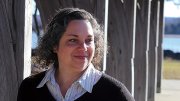The work almost always begins, says writer Cynthia Zarin ’81, with an image she can’t let go of: a pair of gold earrings, a decaying woodpile full of mice and moths, a postcard of a painting by Delacroix. “I don’t start with an idea,” she explains. “I’m not coming in with something I want to say. I find out what I am thinking by writing.” One word comes, and then another, and another, until the meaning emerges. “It’s the language that leads you there,” she says. In a roving creative life that has included poetry, memoir, essays, journalism, children’s books, and—most recently—a novel, this process has been the constant. In “November,” a poem on love, published late last year in The New Yorker, she started with an image of nine swallows on a leafless beech tree, which she remembers glimpsing from a window in upstate New York. In a Paris Review essay, “The Sofa,” what began as a description of an old piece of furniture became a meditation on her father’s death.
Inverno, Zarin’s first novel, published in January, opens with a woman named Caroline standing in a snowstorm in Central Park, waiting for a phone call from Alastair, with whom she has had an intense, complicated relationship for 30 years, undulating across marriages and divorces and the aftereffects of the lovers’ painful childhoods. The spot where Caroline waits, near the park’s ball fields, is only a few yards from where Alastair used to hide as a boy four decades earlier, covering himself with leaves.
From that image, the novel flows outward, elliptical and dreamlike, slipping back and forth across time, bits of memory accumulating alongside flashes of revelation. The story is not so much a chronology as a series of associations, scattered with recurring images and digressions—into Scandinavian fairy tales, Hollywood movies, the cultural history of rotary telephones. The effect is beautiful, even when it’s bewildering. “They do not know yet that the stories that are repeated are the important ones, that the point of the story is that it is repeated, that inside the story is a fairy tale, a walnut shell, a tiny boat, a tin can,” Zarin writes toward the end of the book, in a scene that involves Caroline’s grown children. As the narrative fills in, that initial split image—Caroline in the park, waiting for Alastair next to what feels like a ghost of his younger self—surfaces again and again, comes to seem emblematic of love’s incurable crookedness, with its crossed paths and aching absences and missed communications. “How unwise it is to look back,” the narrator reflects. “But it is all we know, the pictures hanging in our little hut of time.”
Zarin’s first literary pursuit was poetry. Now a longtime contributor to The New Yorker and a senior lecturer at Yale, whose books include five collections of poetry (with a sixth, Next Day: New and Selected Poems, due this summer), she remembers being four years old when the letters of the alphabet suddenly “fell into place.” Right away, she began writing poems. “I wanted to live in there,” she says, “in those words.” Zarin’s whole childhood was spent reading: “My memories are almost all books.” She grew up in New York, one of three siblings whose father was a lawyer and investment banker and whose mother was an administrator at, and later a trustee of, Queens College. As young girls, she and a friend would spend all day in the library, reading (Edward Eager ’35 and E. Nesbitt were favorites), and then acting out the stories they had devoured.
She came to Harvard in 1977 to study with poet Robert Lowell ’39, but he died three days after her arrival (see “The Brahmin Rebel,” May-June 2004, on his Harvard connections). Instead, her advisers became Boylston professors Seamus Heaney, Litt.D. ’98 and Robert Fitzgerald ’33. “Extraordinary teachers,” she says. “I was very, very lucky.” Fitzgerald’s class on versification was a particular influence. His expectations were high, she recalls, and he famously graded assignments in coded abbreviations: N.T.B. (“not too bad”), N.B. (“not bad”), N.G. (“no good”). After graduation, Zarin earned an M.F.A. from Columbia University and then joined The New Yorker, where, after three days in the typing pool, she was invited to be an assistant to the magazine’s legendary editor William Shawn and ascended from there into its ranks of writers, covering culture and the arts—and publishing her poems. (She recounts this experience in “Mary McCarthy’s Chest,” a fly-on-the-wall essay full of keen observations that concludes her 2013 memoir An Enlarged Heart: A Personal History.)
As a work of fiction, Inverno is in some ways a departure from Zarin’s other writing, but emotionally and thematically—even linguistically—it feels in conversation with previous books of hers, such as The Ada Poems, inspired by Nabokov’s 600-page looping fantasia about an obsessive love affair between a brother and sister; or the deeply personal essays in Two Cities (2020). That book is a meditation on the Italian cities of Venice and Rome, but it’s also a study in yearning and desire, and Zarin’s narrator is preoccupied by a tangled, ebbing relationship with a partner who remains absent and unnamed, finally becoming a “ghost” who haunts her steps.
At times, the essays read almost like letters; and Inverno, too, initially began as a letter addressed to someone in Zarin’s life. But she quickly realized she would probably never send it, and it “took on a life of its own,” morphing over nearly a decade into a long piece of ever-expanding prose that she kept adding to, without quite knowing what it would become. In the end, artistic friends and a literary agent in London helped her reimagine it as a novel. “We kind of drew the structure of Inverno on a napkin in a restaurant in Sloane Square,” she says. “That’s when it really started to be something.”
Now, Zarin is working on a second novel, Estate (which means “summer” in Italian, the inverse of Inverno’s “winter”). The new novel isn’t exactly a sequel to her first, she says, but, like Inverno, it revolves around the story—and imagery—of Caroline.









